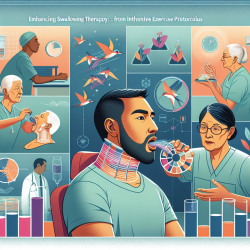In the quest to optimize therapeutic interventions for children, leveraging data-driven insights is paramount. The study titled "Nonspeech sequence skill learning under single and dual task conditions in adults who stutter" by Bauerly and De Nil (2015) offers valuable insights into motor learning and its implications for speech therapy. This blog aims to distill the key findings of the research and provide actionable recommendations for practitioners.
Key Findings from the Study
The study compared practice effects and learning abilities in 11 persons who stutter (PWS) and 12 persons who do not stutter (PNS) using a finger-tapping task under single and dual task conditions. The key findings are:
- Performance Improvements: Both PWS and PNS showed significant improvements in reaction time and sequence duration with practice. However, PWS demonstrated slower performance gains compared to PNS.
- Retention of Skills: PWS were able to retain the task for accuracy and sequence duration but not reaction time after a 24-hour retention period.
- Interference Effects: PWS exhibited larger differences in performance when transitioning from single to dual task conditions, indicating greater sensitivity to interference.
Implications for Practitioners
Understanding these findings can help practitioners tailor their therapeutic approaches to better support children who stutter. Here are some actionable recommendations:
- Extended Practice: Given that PWS showed continued improvements with extended practice, incorporating longer practice sessions can be beneficial. This aligns with the study's finding that PWS may benefit from extended practice to achieve similar levels of performance as PNS.
- Focus on Retention: Practitioners should emphasize retention strategies in their interventions. This can include spaced repetition and varied practice to enhance the stability of newly acquired skills.
- Dual Task Training: Incorporating dual task training can help improve the automaticity of speech motor patterns. By gradually increasing the complexity of tasks, practitioners can help children better manage interference and improve their fluency.
Encouraging Further Research
While the study provides valuable insights, it also highlights the need for further research, particularly in understanding the underlying mechanisms of motor learning in PWS. Practitioners are encouraged to stay abreast of the latest research and consider participating in or supporting studies that explore these areas.
To read the original research paper, please follow this link: Nonspeech sequence skill learning under single and dual task conditions in adults who stutter.










